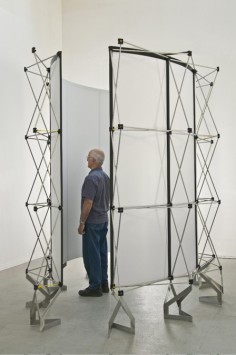MOWRY BADEN
Perception Machines
source: canadianartca
Until his retirement in 1997, Baden spent more than 30 years in the classroom. He taught first in California, where he was born and raised, then in Vancouver and, finally, in the Department of Visual Arts at the University of Victoria, where he worked for 22 years with colleague Roland Brener (who died in March 2006). Baden’s own work incorporates elements from perceptual psychology, science and phenomenology. The viewer interacts with sculpture that provokes, in Baden’s term, “a perceptual crisis.” A winner of the 2006 Governor General’s Award in Visual and Media Arts, Mowry Baden is considered a pioneer of body art.
If a student “weighs-in light,” he explains in a ruminative yet precise voice, “for example, coming in with an idea framed on an anime video that doesn’t come close to hitting bedrock”—he talks with the student, trying to guide her to “touch bottom.” What cannot be taught is: “Patience, perseverance and curiosity, because these features are in the bloodstream of the creature that stands in front of you—or not. If they can’t hold focus, you can’t implant it.”
With A Cappella, Baden has fashioned a science-fiction-worthy sound chamber built from the prefabricated pop-up walls often seen in trade show displays. The work’s curved enclosure produces a baffling effect that deadens external noise while reflecting captured sound back to the viewer; its echo subtly distends time and space.


